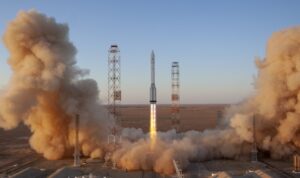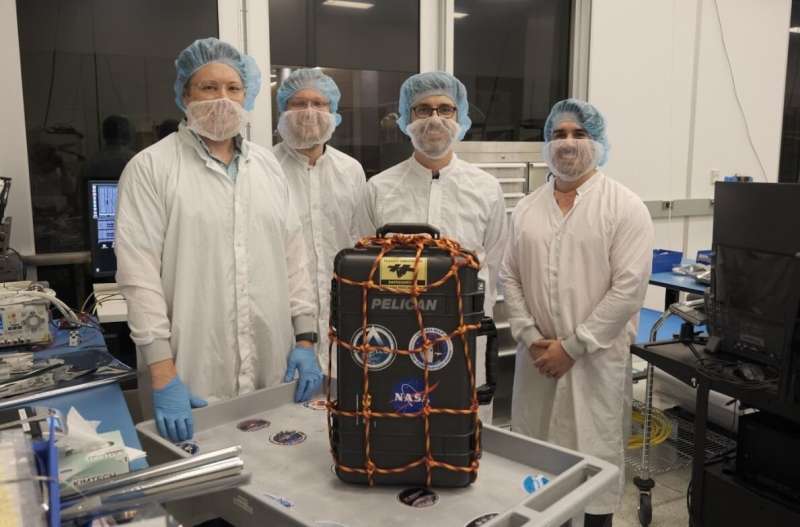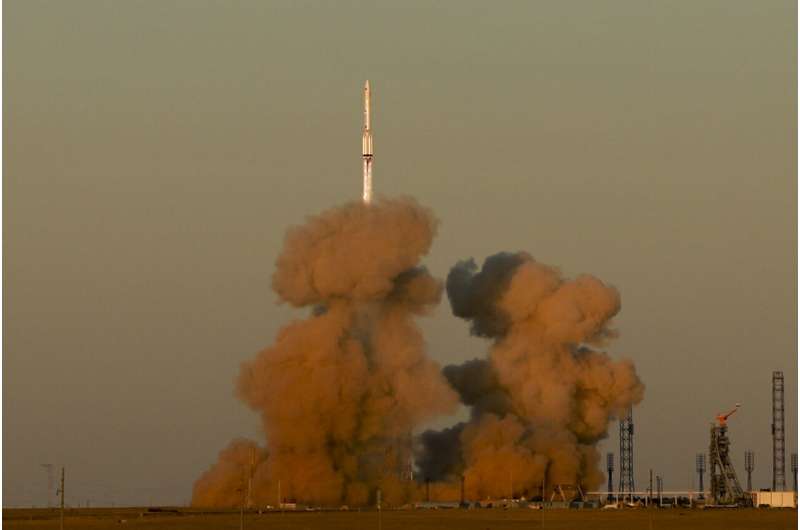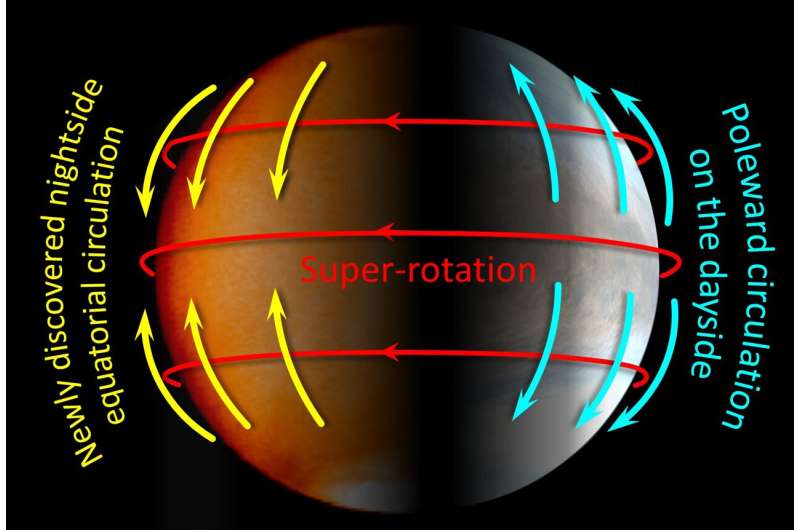NASA seeks industry feedback for Artemis Moon Landing Services
Thursday, 22 July 2021 00:10 NASA initiated collaboration with industry in the agency's first formal step in establishing regular crewed transportation to the lunar surface as a part of Artemis. In a request for information (RFI), NASA is asking U.S. companies for feedback to inform the agency's plan for purchasing human landing system services to ferry astronauts from Gateway in lunar orbit to the surface of the Moon.
NASA initiated collaboration with industry in the agency's first formal step in establishing regular crewed transportation to the lunar surface as a part of Artemis. In a request for information (RFI), NASA is asking U.S. companies for feedback to inform the agency's plan for purchasing human landing system services to ferry astronauts from Gateway in lunar orbit to the surface of the Moon. The weather forecast for Venus
Thursday, 22 July 2021 00:10 Little is known about the weather at night on Venus as the absence of sunlight makes imaging difficult. Now, researchers have devised a way to use infrared sensors on board the Venus orbiter Akatsuki to reveal the first details of the nighttime weather of our nearest neighbor. Their analytical methods could be used to study other planets including Mars and gas giants as well. Furthermore, the st
Little is known about the weather at night on Venus as the absence of sunlight makes imaging difficult. Now, researchers have devised a way to use infrared sensors on board the Venus orbiter Akatsuki to reveal the first details of the nighttime weather of our nearest neighbor. Their analytical methods could be used to study other planets including Mars and gas giants as well. Furthermore, the st 'I pump but don't dump' bitcoin, says Musk
Thursday, 22 July 2021 00:10 Tesla founder Elon Musk said Wednesday he personally has invested in bitcoin and other cryptocurrencies but that he does not manipulate or "dump" the digital currencies.
In a wide-ranging online panel discussion that included Twitter and Square founder Jack Dorsey, Musk said he believes in cryptocurrencies as a way to "increase the power of the individual in relation to government," and that
Tesla founder Elon Musk said Wednesday he personally has invested in bitcoin and other cryptocurrencies but that he does not manipulate or "dump" the digital currencies.
In a wide-ranging online panel discussion that included Twitter and Square founder Jack Dorsey, Musk said he believes in cryptocurrencies as a way to "increase the power of the individual in relation to government," and that NASA conducts 5th test in RS-25 series
Thursday, 22 July 2021 00:10 NASA conducted a fifth RS-25 single-engine hot fire July 14 as a continuation of its ongoing seven-part test series, supporting development and production of engines for the agency's Space Launch System (SLS) rocket on future missions to the Moon.
Operators fired the engine for more than eight minutes (500 seconds) on the A-1 Test Stand at Stennis Space Center near Bay St. Louis, Mississip
NASA conducted a fifth RS-25 single-engine hot fire July 14 as a continuation of its ongoing seven-part test series, supporting development and production of engines for the agency's Space Launch System (SLS) rocket on future missions to the Moon.
Operators fired the engine for more than eight minutes (500 seconds) on the A-1 Test Stand at Stennis Space Center near Bay St. Louis, Mississip From the sun to the stars: A journey of exoplanet discovery begins
Thursday, 22 July 2021 00:10 The NEID spectrometer, a new tool for the discovery of planets outside of our solar system, has now started its scientific mission at the WIYN 3.5m telescope at Kitt Peak National Observatory, Arizona.
"We are proud that NEID is available to the worldwide astronomical community for exoplanet discovery and characterization," said Jason Wright, professor of astronomy and astrophysics at Penn
The NEID spectrometer, a new tool for the discovery of planets outside of our solar system, has now started its scientific mission at the WIYN 3.5m telescope at Kitt Peak National Observatory, Arizona.
"We are proud that NEID is available to the worldwide astronomical community for exoplanet discovery and characterization," said Jason Wright, professor of astronomy and astrophysics at Penn Webb Telescope to explore a neighboring, dusty planetary system
Thursday, 22 July 2021 00:10 Researchers will use NASA's upcoming James Webb Space Telescope to study Beta Pictoris, an intriguing young planetary system that sports at least two planets, a jumble of smaller, rocky bodies, and a dusty disk. Their goals include gaining a better understanding of the structures and properties of the dust to better interpret what is happening in the system. Since it's only about 63 light-years
Researchers will use NASA's upcoming James Webb Space Telescope to study Beta Pictoris, an intriguing young planetary system that sports at least two planets, a jumble of smaller, rocky bodies, and a dusty disk. Their goals include gaining a better understanding of the structures and properties of the dust to better interpret what is happening in the system. Since it's only about 63 light-years A large tidal stream observed in the Sombrero galaxy
Thursday, 22 July 2021 00:10 According to the latest cosmological models, large spiral galaxies such as the Milky Way grew by absorbing smaller galaxies, by a sort of galactic cannibalism. Evidence for this is given by very large structures, the tidal stellar streams, which are observed around them, which are the remains of these satellite galaxies. But the full histories of the majority of these cases are hard to study, be
According to the latest cosmological models, large spiral galaxies such as the Milky Way grew by absorbing smaller galaxies, by a sort of galactic cannibalism. Evidence for this is given by very large structures, the tidal stellar streams, which are observed around them, which are the remains of these satellite galaxies. But the full histories of the majority of these cases are hard to study, be D-Orbit signs contract with the European Space Agency under the Boost! Project
Thursday, 22 July 2021 00:10 The UK branch of D-Orbit, a leader in the orbital transportation industry, has announced the signing of a contract with the European Space Agency (ESA) under the Boost! Project with ESA's Commercial Space Transportation Services and Support Programme.
The Responsive Microlauncher Service, which provides end-to-end delivery of payloads in orbit, is designed to utilise the upcoming small lau
The UK branch of D-Orbit, a leader in the orbital transportation industry, has announced the signing of a contract with the European Space Agency (ESA) under the Boost! Project with ESA's Commercial Space Transportation Services and Support Programme.
The Responsive Microlauncher Service, which provides end-to-end delivery of payloads in orbit, is designed to utilise the upcoming small lau Astrophysicist outlines plans for the gravitational wave observatory on the moon
Thursday, 22 July 2021 00:10 Vanderbilt astrophysicist Karan Jani has led a series of studies that make the first case for a gravitational wave infrastructure on the surface of the moon. The experiment, dubbed Gravitational-Wave Lunar Observatory for Cosmology, uses the moon's environment and geocentric orbit to analyze mergers of black holes, neuron stars and dark matter candidates within almost 70 percent of the entire ob
Vanderbilt astrophysicist Karan Jani has led a series of studies that make the first case for a gravitational wave infrastructure on the surface of the moon. The experiment, dubbed Gravitational-Wave Lunar Observatory for Cosmology, uses the moon's environment and geocentric orbit to analyze mergers of black holes, neuron stars and dark matter candidates within almost 70 percent of the entire ob Russia launches Nauka module to International Space Station
Wednesday, 21 July 2021 20:33
EL PASO, Texas — Russia launched a long-delayed module for its segment of the International Space Station July 21, but that module reportedly suffered technical problems after reaching orbit.
A Proton-M rocket lifted off from the Baikonur Cosmodrome at 10:58 a.m.
LunaH-Map spacecraft safely delivered to NASA's Kennedy Space Center
Wednesday, 21 July 2021 17:14
The ASU-led team that built NASA's Lunar Polar Hydrogen Mapper, or "LunaH-Map" for short, has safely delivered their spacecraft to NASA's Kennedy Space Center in Florida in preparation for a launch expected later this year on NASA's Space Launch System (SLS) Artemis I rocket.
LunaH-Map is a fully functional interplanetary spacecraft about the size of a large cereal box and weighing about 30 pounds. It is the first mission to be led, designed, assembled, integrated, tested and delivered from the ASU Tempe campus. Its destination is in orbit around the moon, from which it will map water-ice in permanently shadowed regions of the lunar south pole.
Russia launches lab module to International Space Station
Wednesday, 21 July 2021 15:40
Peterson, Schriever, Cheyenne Mountain to become Space Force bases
Wednesday, 21 July 2021 14:47
WASHINGTON — Peterson Air Force Base, Schriever Air Force Base and Cheyenne Mountain Air Force Station will officially become U.S. Space Force bases.
These Colorado-based installations are home to the largest concentration of Space Force personnel.
ERA launch replay
Wednesday, 21 July 2021 14:15 Video:
00:03:07
Video:
00:03:07
The European Robotic Arm (ERA) is on its way to the International Space Station after being launched on a Proton rocket from the Baikonur Cosmodrome, in Kazakhstan, at 16:58 CEST on 21 July 2021.
The 11-m-long robot is travelling folded and attached to what will be its home base – the Multipurpose Laboratory Module, also called ‘Nauka’. The Proton-M booster placed Nauka and ERA into orbit around 10 minutes after liftoff, nearly 200 km above Earth.
The International Space Station already has two robotic arms; Canadian and Japanese robots play a crucial role in berthing spacecraft and transferring payloads and astronauts. However, neither
Space-based infrared imaging reveals the nighttime weather on Venus
Wednesday, 21 July 2021 14:00
Little is known about Venus weather at night, as the absence of sunlight makes imaging difficult. Now, researchers have devised a way to use infrared sensors on board the Venus orbiter Akatsuki to reveal the first details of the nighttime weather of our nearest neighbor. Their analytical methods could be used to study other planets including Mars and gas giants as well. Furthermore, the study of Venusian weather granted by their methods could allow researchers to learn more about the mechanisms underpinning Earth's weather systems.

